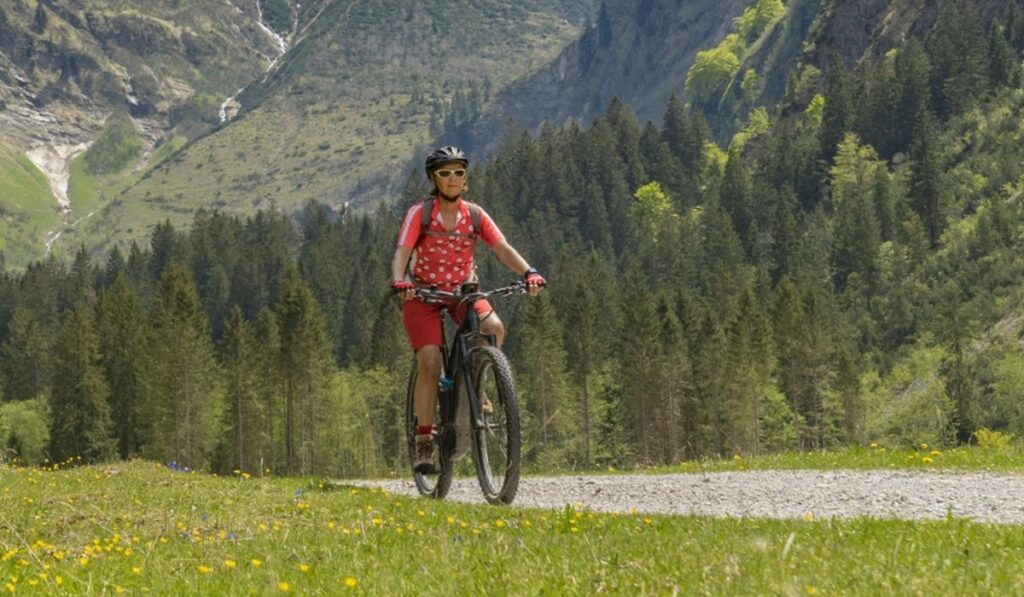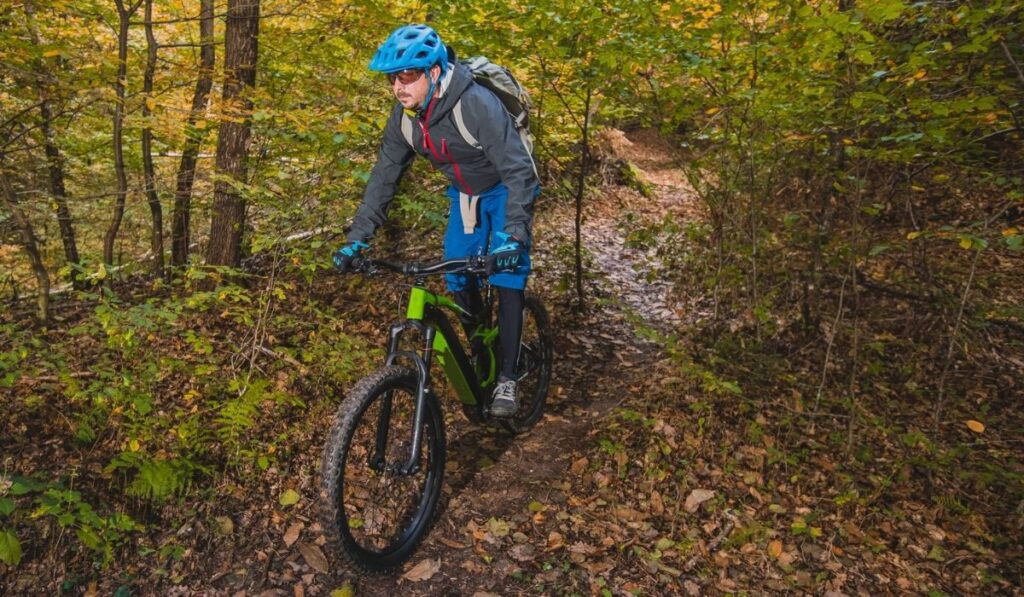You may be considering purchasing an electric bike for city commuting and leisurely travel. But have you ever considered the possibility of mountain biking with an e-bike? Is it even possible to use an electric bike on trails and rough terrain?
Yes, you can use E-Bikes to mountain bike. Not all bikes are suitable for trails and rough terrain though. Bikes with bigger tires, suspension, and sturdy frames are better for this. When riding on a trail, be sure you’re wearing a helmet and going slower than you do on the road.
E-bikes and electric mountain bikes (E-MTBs) serve different purposes and are built differently with those purposes in mind. On top of that, there are certain things to consider when riding on trails. Here’s everything you need to know!
How are Electric Mountain Bikes Different from Normal E-Bikes?

Electric bikes and electric mountain bikes (E-MTB) have different purposes and varying relevant components. One is built for leisurely city commutes and the other for dealing with harsh off-road terrain. The main differences between e-bikes and E-MTBs are the tires, suspension, and frame type.
Tires
E-MTBs generally have larger tires than traditional electric bikes. These tires come with outer diameters ranging from 26″, 27.5″, or 29″ with widths from 1.9″ to nearly 5″.
E-bikes meant for the pavement are going to have smaller tire sizes. On top of that, mountain bike tires are going to have extra texture for increased tread.
Suspension Systems
E-MTBs are also going to have suspension systems in place to reduce shock while riding on rougher terrains. This system includes a fork in the front and shock in the back.
The fork holds the front wheel, and the shock is incorporated into the frame, controlling the back wheel. Most average road bikes will lack this feature.
Robust Frames
E-MTBs are also going to have more robust frames that can take a beating. These frames will typically be heavier than road bikes, making it harder to pedal uphill and on asphalt.
You’ll find E-MTBs with frames made from aluminum, steel, carbon fiber, and titanium.
On top of all that, there are differences in gears and general components. Each type of bike serves a unique purpose and has different various pros and cons. The choice comes down to your preferences, needs, goals, and personal riding style.
Why are E-Bikes Banned on Some Trails?
The use of electric bikes on trails is banned in some cities and states. Whether you agree or disagree with this decision, there are reasons for it. Electric bikes are typically prohibited on trails due to speed, trail health, and other factors.
Speed
Electric bikes have a higher average speed than conventional bicycles, which may contribute to their ban. Traditional bicycles travel at a reasonably consistent speed regardless of the rider’s fitness level.
E-MTB and e-bikes however can travel much faster than this due to their additional motors and batteries. This added speed can increase the risk of accidents and endanger riders.
Throttle
Another factor to these bans is the throttle on e-bikes. The throttle, pedal-assist, and added speed on electric bikes can damage trails. This damage can build up and ruin paths for riders and hikers alike.
Trail Etiquette
Trail etiquette also plays into these decisions. Cyclists, hikers, horseback riders, and other individuals all use trails. There are established sets of rules and regulations to follow so no one gets hurt.
New e-bike riders may not have a full grasp of these guidelines. Combine that with the added speed of electric bikes, and you may have a dangerous situation.
Other Reasons
Other potential reasons for these bans include the risk of e-bike riders getting lost or running out of battery. New e-bike riders may not understand their bike or the trails to the fullest extent, so may end up in some sticky situations when learning the ropes.
On top of that, e-bike riders can trump athletic achievements and records from other riders on popular fitness apps like Strava.
Are E-Bikes and E-MTBs allowed in National Parks?
Yes! As of 2019, electric bikes are allowed in national parks across the U.S. This is due to e-bikes no longer being classified as motorized vehicles.
However, using the throttle may not be permitted on some trails. Additionally, some parks may limit area and trail access for e-bikes depending on the classification of your e-bike.
Riding Electric Bikes on Trails: What to Look Out For

There are a few things to be aware of when riding electric bikes and E-MTBs on trails. You should keep in mind the guidelines of the trail, your riding style, and the terrain of the trail.
- Follow the Guidelines: The general rules are the first thing to keep in mind when riding on trails. Always double-check that the path allows e-bikes and, if yes, check if there are any specification limits. Be courteous to other riders and follow proper trail etiquette. Doing so will give you and other riders in your community a better name!
- Pedal More and Faster: Be sure to pedal more and quicker when you’re riding on trails. You may want to up your riding cadence by 10-30rpm. Increasing your cadence will increase the efficiency of your motor and prolong your battery life.
- Control your Power Output: Use your bike’s throttle sparingly on trails. Saving your throttle specifically for those challenging climbs and steep hills will help prolong your battery life. On top of this, you’ll want to get a feel for the trail and your throttle. If misused, you could flip backward and harm yourself.
- Watch your Brakes: With an electric bike, you’ll typically want to brake earlier than you usually would with a conventional bike. Be aware of your speed and when you need to brake while riding to avoid losing momentum at the wrong moments.
- Watch the Terrain: Be sure to focus on the landscape of the trail. E-MTBs are going to ride differently than traditional bikes. Select your line carefully and use different riding techniques for added control. Get a feel for both the trail and your bike’s power for the best results.
With these tips in mind, you’ll be able to have a more enjoyable and safer trail riding experience. Be sure to properly maintain your bike, as trails can give your e-bike a beating.
Don’t forget to relax your grip a little as well; white-knuckling the handlebars will add to your fatigue. Lastly, ride often and enjoy it!
